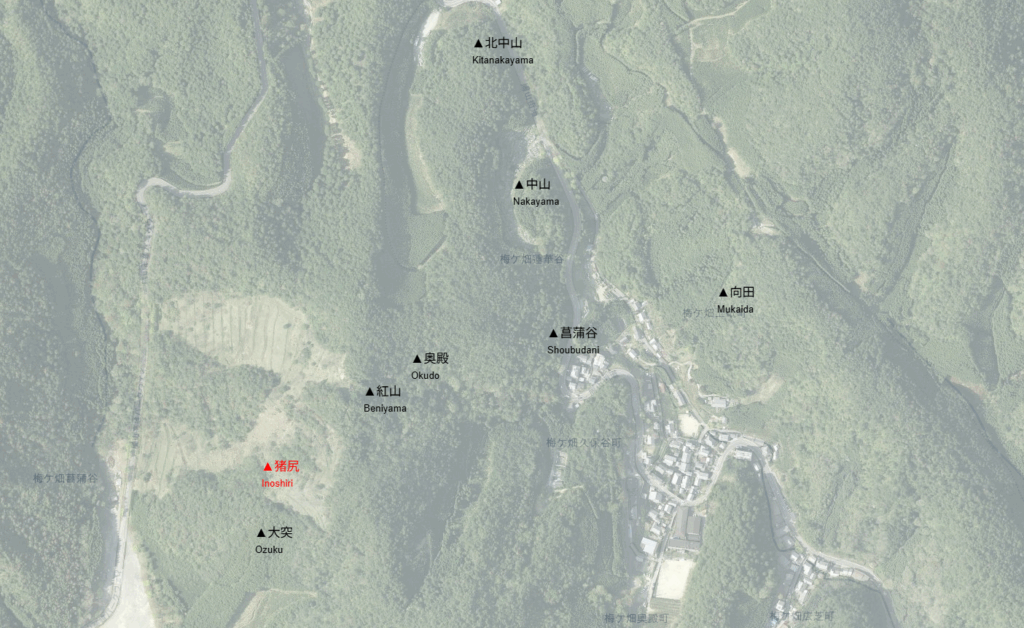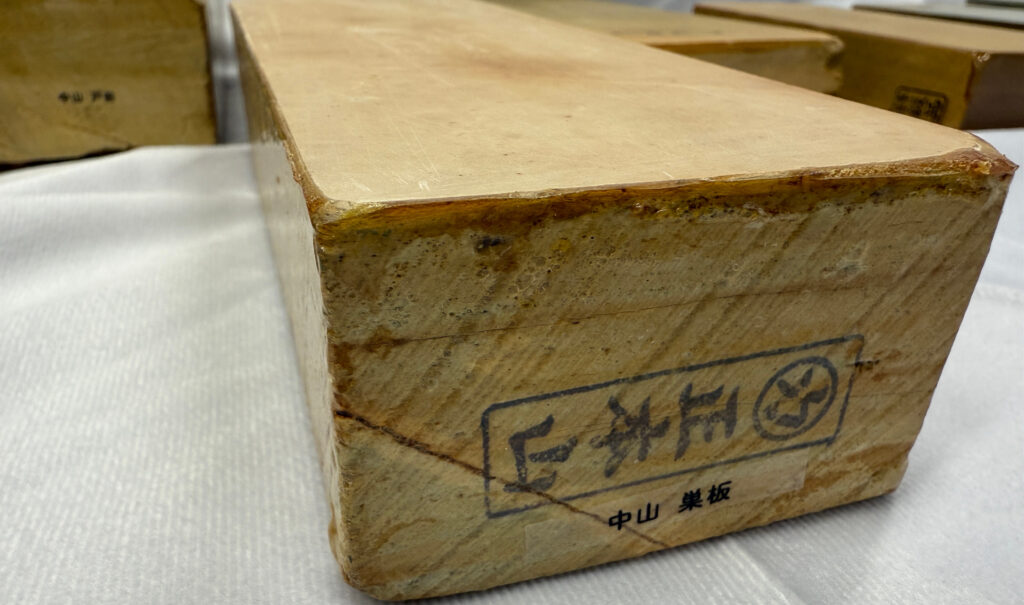
Nakayama whetstone is known as the “king” among Japanese natural whetstones. Its overwhelming sharpening performance and beauty of finish have made it the object of admiration of knife enthusiasts and sharpeners around the world. Behind the stone, however, there is a story of “history” and “distribution” that is more than just a stone. In this article, we will unravel the story of how Nakayama whetstone was distributed and increased in value, focusing on the Nakayama Mine (commonly known as the Kato Mine), which is now closed, and the episodes surrounding the famous “Maruka” label.
What is Nakayama Grinding Wheel?

Nakayama is the name of a grinding stone production area located west of Umegahata, Ukyo-ku, Kyoto City. From the Nakayama hills at an elevation of approximately 200 meters, many layers of stone such as Zuita, Tozen, Mizuasagi, Shiroasagi, Kurumaguchi, and Gosa have been mined. The fineness of the grain, smoothness of the sharpening feel, and beauty of the finish distinguish this area from other production areas. Since mining is no longer conducted, all are either “dug-out stock” or “antique,” and their rarity and value are increasing every year.
Nakayama Mine = Kato Mine?
The family that actually owned the Nakayama grinding stone mining area was known as the “Kato Mine” or “Kato Family. From the Meiji era to the Showa era, the family managed and mined the Nakayama shale deposits for several generations. At one time, the company was incorporated, and the names “Kato Mine Corporation” and “Kato Shoten” are recorded in the company registry. The Kato family was the most legitimate owner of mining rights in Nakayama and is known for its stable supply of high-quality grinding stones, especially before and after World War II. Nakayama, Okudo, and Ozukuri are the administrative areas known as Umegahata (Ukyo-ku, Kyoto City). According to old documents, Umegahata is an old village that has existed since the Heian period. In the Kamakura period (1185-1333), with the rise of sword making, Mr. Sato and Mr. Suzuki did not own this area, which was famous for producing whetstones, but it was under the jurisdiction of temples and shrines during the manorial period and directly controlled by the shogunate since it was such an important area. During the Meiji Restoration (1868-1912), the land was sold to the private sector, and although it is unclear how it came to be, it seems to have been owned by the Kato family.
The Kato family itself did not seem to be a samurai family, as not much data could be found. It was probably a family of landowners and merchants in Kyoto City, who acquired forests and developed a mining business after the Meiji era (1868-1912). A brief summary is as follows.
Ownership and distribution of Nakayama grinding stones
| the times | Owner/manager | remarks |
|---|---|---|
| Edo period (1603-1868 CE) | Bakufu or temple or shrine territory | Mining is by permit only. There is management of the Imperial Grindstone. |
| Meiji – Early Showa Period | Landlords and newly emerging merchants (Kato family, etc.) | Private ownership of land is transferred due to the revision of land tax. Mining becomes active. |
| Mid to late Showa Period | Kato Mines + contract miners + 5 dealers | The Hatanaka Grinding Wheel Store and others are now in charge of sales. |
Who is “Malka?”

The “Maruka mark” is an indispensable part of the Nakayama whetstone story. The branding mark “Maruka ni Ka” on the side of the whetstone is commonly known as “Maruka Nakayama” and has earned the special trust of professional sharpeners. This “MARUKA” brand was handled by a wholesaler called Honma Honma Stone Shop (Honma Family) in Kyoto City, which is said to have had a very close relationship with the Kato Mine.
The Honma family is often mentioned, but as far as we have been able to determine, they were not the owners of the mine itself, but were connected to the Kato Mine as wholesalers responsible for the distribution of Nakayama whetstones. There was a theory that they jointly owned the mine with the Kato family, but so far we have not been able to find any such documents in the registry. The Honma family did not own the mining rights, but only purchased “selected” whetstones from among those mined by the Kato family, sorted them by their own connoisseurs, and shipped them with the Maruka seal. Because the selection standards were extremely strict, the image of “MARUKA = never misses” took root and became a successful brand. The name “MARUKA” is derived from “Maru” and “Ka” of Kato Mine.
What made “Marka Nakayama” so special?

Natural whetstones, even those from the same mountain, vary greatly in quality. Differences in layers, moisture content, presence or absence of nests, and the way abrasive power is produced are all individual differences due to the fact that they are “natural. For this reason, the branding “MARUKA” has served as a sign that the piece has been selected by a trusted connoisseur. Even today, MARUKA Nakayama pieces in good condition on the second-hand market often fetch more than 1 million yen.
Hatanaka” is one of the natural whetstone brands sold by Hatanaka Shoten in Kyoto City, which in the mid-Showa period handled high-quality whetstones, mainly from Nakayama. Nakayama whetstones with “Hatanaka” logo labels still command a high price.
The notation “Shohonzan whetstone” is also seen, but this is an expression used to indicate that it is a Nakayama whetstone from the Kato Mine, and the format of the branding or labeling is not consistent. In recent years, reliability has varied, and careful judgment is required.
A comparison of brands can be summarized as follows
| brand name | implication | source | feature |
|---|---|---|---|
| Maruca Nakayama | Honma Family Selected Nakayama Grinding Stones | Kato Mine × Honma Wheel Shop | Selected items, branding available |
| Hatanaka Grinding Wheel | Nakayama Center of Hatanaka Shoten Sorting | Kato Mine Center (and others) | Practical and professional |
| Shohonzan whetstone | Brands with the notation “authentic Honsan.” | Some are in Nakayama, others are | Vague, needs attention |
What is Junsho-Honzan?
Grinding stones from the Umegahata area often printed with the label “Junshinsho Honzan” are also rare and fetch a high price. It is a common occurrence in the whetstone industry that many of them are fakes that have been stamped on later, perhaps crudely. Junsho-Honzan” reads as follows:
Junshinsei Honzan Each Kanji reading is:
Jun ( pure )
Shinsei
Honzan
The meaning is “pure, genuine, and genuine Honzan (= Nakayama) whetstone. The meaning of the trademark name is to emphasize that it is a pure and genuine Honzan (=Nakayama) whetstone. Especially after the war, Hatanaka Abrasive Stone Shop registered this trademark and is said to have used it as a guarantee of quality, saying that the stone is a genuine Nakayama stone from Kato Kozan. Along with the “Ka (maruka) in a circle” stamped on Nakayama whetstones, the branding or seal of “Junsho-Honzan” was considered a sign of trust. It has a deep and interesting historical background.
We also checked the registered trademark.

Trademark Information (“Junshinsho Honzan”)
Trademark (registered name): Junshinsho Honzan
Trademark applicant/right holder: Hatanaka Abrasive Stone Co.
Filing date: May 18, 1953
Registration date: March 8, 1954 (Showa 29)
Registration number: Registration 0441616 (Commercial Application 28-012826)
Name (reading): Jonshinsho honzan, Junshinsei honzan
Classification: Class 08 (cutlery, tools, etc.)
Status: Existing, registered, continued
It was registered by Hatanaka Wheel to show “legitimacy” in the postwar Nakayama wheel market, and the registration confirms the background of the use of the MARUKA mark + Junsho-Honzan as “a sign of trust in Nakayama Wheel”. Incidentally, it is interesting to note that this trademark is still “in existence” today. Whether or not Hatanaka Grinding Wheel Co., Ltd. is still in existence, this means that the trademark right itself has not expired.
Sources and characteristics of Nakayama whetstones handled by the Tottori family
Currently, there are a number of specialty shops that specialize in Nakayama whetstones, such as Tottori-ya,Toshiya, Honmamon, and Gokitcho. Nakayama whetstone is often sold on Yahoo! Auctions and Merrika, but there are many fakes, so if you want to try it for the first time, we recommend that you purchase from a specialist whetstone supplier.
Maruo-yama natural whetstone, but in recent years they have also been actively dealing in Nakayama and other “Azumamono” whetstones.
A particularly strong theory is that the Tottori family purchased Nakayama and Okudono rough stones and stock that had been stored by Hatanaka Shoten, which had once closed its business, in bulk. The Nakayama whetstones sold by the Tottori family have old label marks, hand-engraved letters, and features that appear to be dead stock in boxes, which may support this theory.
Comparison of Tottori Ie Nakayama and Maruca Nakayama
| point of view | Maruca Nakayama | Tottori Family Nakayama |
| source | Kato Mine × Honma Wheel Shop | Gemstones bought back or old stock reshaped |
| brand (burnt-in mark of identification) | Branded with “KA” (Kato in a circle) on the ○. | No branding or Kato Mountain and Nakayama engraving only |
| Labels. | Japanese paper / gold leaf / red and blue, etc. | Basically none. Label marks can remain. |
| sorting | Selection by strict connoisseurship | Plastic surgery sales with emphasis on quality for practical use |
| target demographic | Collector/Professional Laborer | Practical-minded sharpeners and enthusiasts |
summary
The value of Nakayama whetstones cannot be expressed only in terms of grinding ability or appearance. The value of Nakayama whetstones as a culture lies in the background of who digs them, who selects them, and how they are distributed. To touch a whetstone is to touch the culture and history of the tool. Knowing the story behind the label and branding, you will feel the weight of a single stone even more deeply. If you are going to use the stone as a tool for practical use, not for collection, you should choose a natural whetstone according to the steel material of the knife you want to sharpen and what kind of image you want to give to the knife. There are many other interesting whetstones in the world besides MARUKA. I would like to conclude by saying that I think it is also wonderful to travel around the world to find the one whetstone that is right for you.
